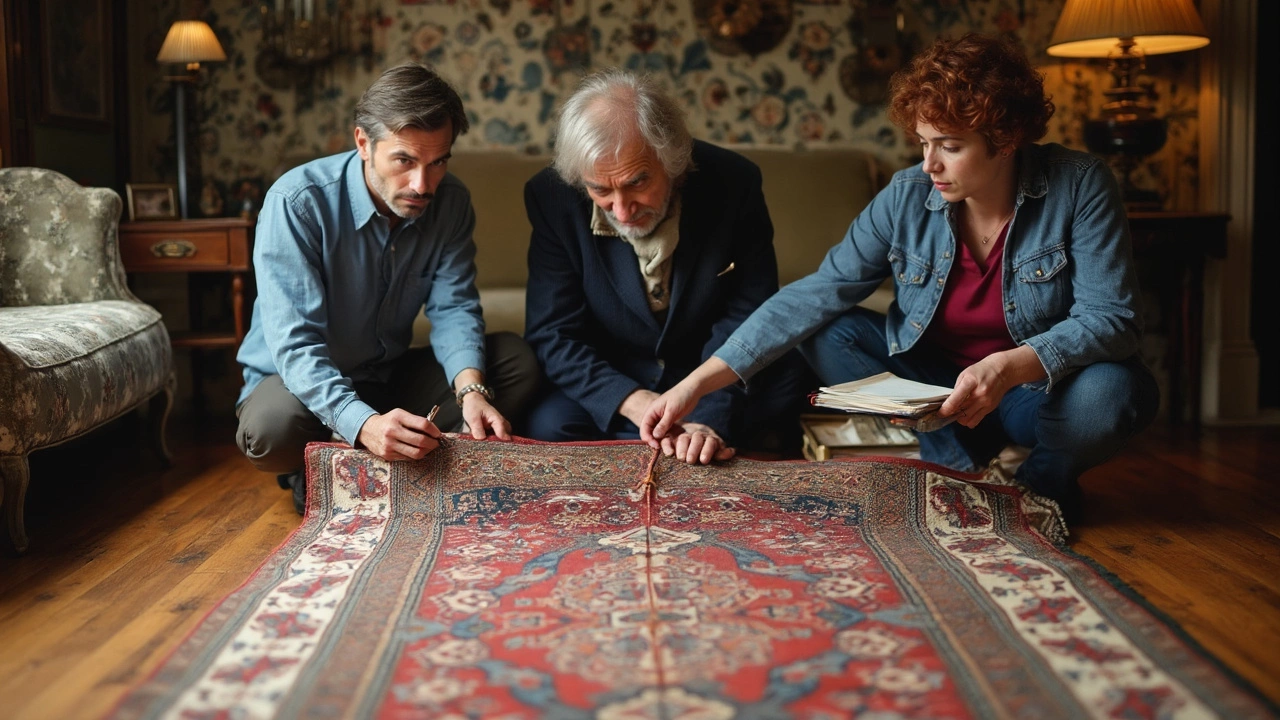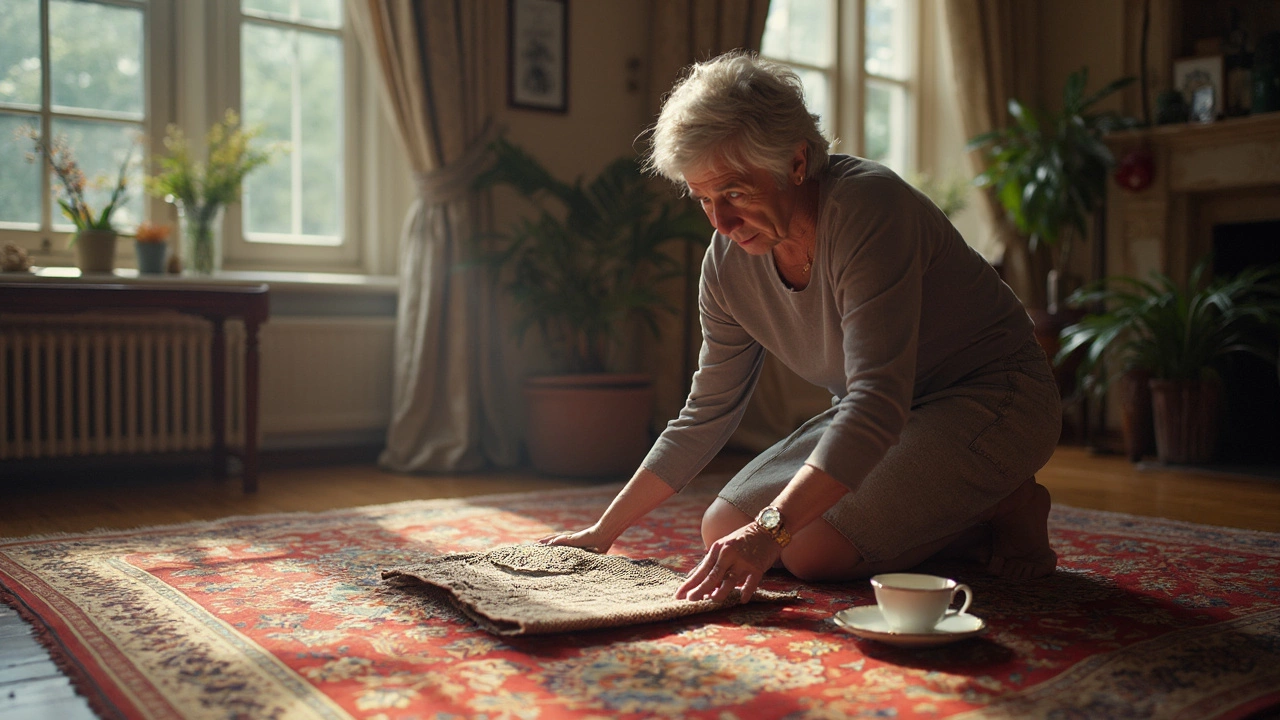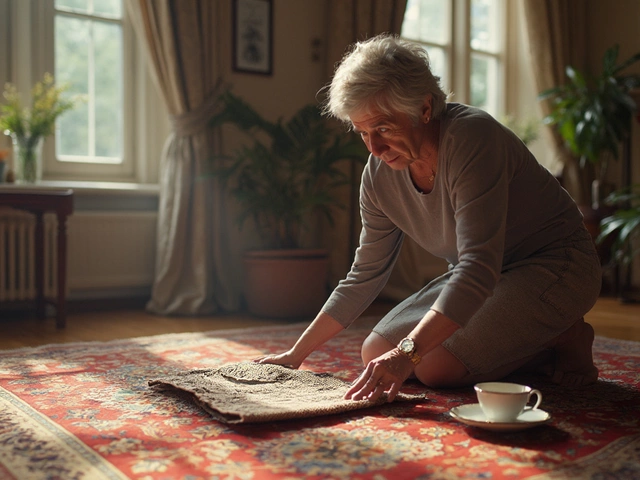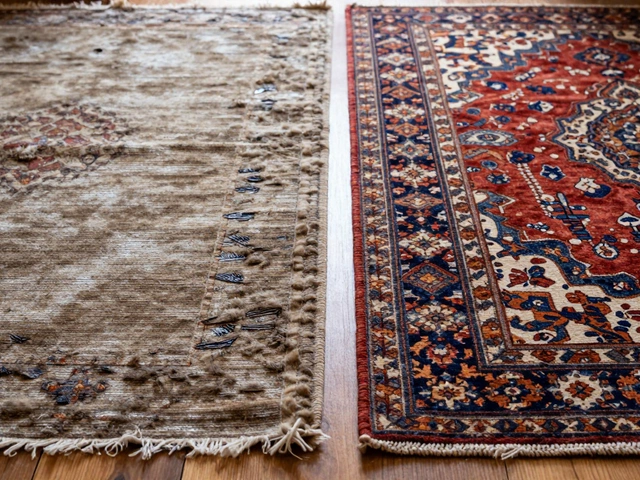People always fuss over the colors and patterns on the front of a rug, but the real story is hiding underneath. When you flip it over, you can spot signs of age, craftsmanship, and even if you’re about to get ripped off. That’s why rug pros don’t just glance at the design—they go straight for the back.
If you’re buying a rug—especially an expensive one—checking the back is a game-changer. You’ll see loose threads, weird patches, super straight lines, or perfect knots. These are giant clues. Is it handmade, machine-made, or some mix in between? The answer’s in the backing. Want to judge quality without having to trust a salesperson? The knots, weaving, and finish on the back are where the facts live.
- Handmade vs. Machine-Made: Signs from the Backing
- Reading the Knots and Patterns
- Clues About Quality and Durability
- Smart Shopping: What to Check on the Back
Handmade vs. Machine-Made: Signs from the Backing
You can usually tell right away if a rug is handmade or machine-made just by flipping it over. That’s where you find all the real evidence. While the front looks fancy, the back tells the truth about the rug’s origin.
- Rug backing in handmade pieces usually shows messier, less perfect knots. These knots are often uneven, and you’ll probably see tiny differences from one area to another. That’s because actual people tied each knot by hand. You might spot bits of thread sticking out or color changes woven in by a real person.
- On a machine-made rug, the back looks super consistent. The lines and knots are too perfect. There won’t be weird threads poking out. If you see a mesh or fabric glued to the back, that’s another giveaway that a machine did all the work. With these rugs, you’ll often see white plastic-looking threads making a grid pattern.
Here’s a quick cheat sheet for spotting the difference:
| Clue | Handmade Rug | Machine-Made Rug |
|---|---|---|
| Knot pattern | Irregular, not perfectly spaced | Super consistent, even spacing |
| Backing material | No glued-on backing, just knots | Often has a glued mesh, latex, or cloth |
| Thread ends | Visible, might stick out | Neat, tucked, or hidden |
| Fringe | Continuation of structure | Sewn or glued on after rug is made |
This stuff matters for value, too. Real, handmade rugs—especially vintage or antique ones—can be worth way more than machine-made lookalikes. If you’re shopping secondhand, always check the back. You might score a find among the piles if you know what to look for.
Reading the Knots and Patterns
Here’s the real secret: the back is like the rug’s birth certificate. When you’re checking a rug, knots and patterns woven on the backside reveal how much effort—and sometimes skill—was actually poured into making it. If you see knots tied one by one with slight irregularities, you’re looking at a hand-knotted rug. That’s the gold standard for collectors and usually one of the first things experts check. On the other hand, if the knots are too perfect or you see a mesh or latex holding fibers together, it’s probably a machine-made rug.
There’s even more to spot:
- Rug backing should mirror the front but look a bit tighter and less fuzzy—think of it as an x-ray of the design.
- Real hand-knotted rugs usually show each color knot like tiny dots or pixels, with small crookedness that proves it’s not churned out by a robot.
- If you see long, uniform strands running the length (these are called weft or warp threads), and little rectangles holding yarn in a factory pattern, it’s machine-made.
- Tufted rugs—sort of a middle ground—have a cloth or canvas backing glued on. You can’t see individual knots at all, which is a dead giveaway.
Want to get nerdy? The more knots per square inch (KPSI), the denser—and often more valuable—the rug. Here’s how some common rug types stack up:
| Rug Type | Average KPSI |
|---|---|
| Persian Tabriz (hand-knotted) | 120-400 |
| Afghan (handmade) | 50-120 |
| Machine-made synthetic | Under 50 |
There’s no need for special tools. Just roll a corner up and study the back under good light. If you feel rough knots and see uneven rows and little color dots, odds are you’ve hit the jackpot with something authentic. Super crisp, grid-like patterns are a red flag for mass production. This trick works whether it’s a tiny doormat or a huge living room piece.

Clues About Quality and Durability
The first thing you want to check on the back of a rug is how the knots or tufts look. For a high-quality rug, the knots on the backside are tight, even, and packed together without gaps. Loose, wonky knots or uneven spacing? You’re probably looking at something cheaper or mass-produced. Experts will tell you: a tightly-knotted rug not only feels stronger, it usually lasts way longer under real-life foot traffic and messes.
Now, peek at the edges. Are they wrapped with thick, neat binding or are there frayed threads and sloppy stitches? Good edges mean less unraveling later, which is especially important in busy parts of the house. If the backside has a stiff plastic or rubber layer, it’s a dead giveaway for a lower-end, machine-made rug. Those backings crack with age and don’t let the rug breathe, so mildew and bad smells creep in over time.
If you spot color bleeding on the back, that’s a red flag for poor dyes or quick production shortcuts. The best rugs use colorfast, natural dyes that won’t run all over your floor after the first cleaning. You might also see a unique pattern mirrored on the back (like a pixelated version of the front); that’s another sign of a well-made piece, especially with hand-knotted or handwoven rugs. If the backing is blank or there’s just some fuzzy glue, you’re not getting much quality or durability there.
- Even, compact knots mean better strength and longer life.
- Well-finished edges prevent fraying and unraveling.
- Natural or cotton wefts are signs of genuine, quality craftsmanship.
- Rug backing that’s glued or rubbery often points to a cheap, short-lived product.
- Check for pattern clarity—if it matches the front, you’re likely looking at real quality.
So, next time you check out a rug, flip it over and give the back a real inspection. It tells you a lot more about how long that rug will actually survive kids, pets, spills, and everyday life.
Smart Shopping: What to Check on the Back
If you want to make sure you’re not getting fooled at the rug shop, flip that bad boy over before handing over your credit card. The back is packed with clues that tell you what you’re really buying. Here’s exactly what you should look out for when checking the back of a rug, and why it matters.
First off, check whether the back looks just like the front, only fuzzier and less bright. That’s how handmade rugs look—you actually see the pattern reflected through. Machine-made rugs usually have a stiff, almost plastic mesh backing, or they might look too perfect. If the design at the back is muddy or covered with glue, it’s probably mass produced. When in doubt, run your fingers over the rug backing. A flexible, soft finish usually means better craftsmanship.
- Knots: On handmade rugs, you’ll spot tiny, uneven knots. They won’t line up like soldiers, but that’s good—it means real people wove it. Machine-made knots are always uniform and often hard to tell apart.
- Stitch Lines: If you see perfect rows of machine stitches or a thin fabric stitched over the back, it’s definitely machine-made.
- Edge Binding: Handmade rugs often have slightly wonky, thicker edge bindings. If the edge looks glued or perfectly uniform, it’s probably not hand-crafted.
Numbers tell the story too—the knot count. Higher knots per square inch almost always mean a stronger, more durable rug. Here’s a cheat sheet:
| Knot Type | Knot Count (per sq in) | Durability | Main Use |
|---|---|---|---|
| Low (Machine-made) | <50 | Low | Decorative, budget buys |
| Medium (Handmade) | 50-200 | Medium | Living rooms, bedrooms |
| High (Fine Handmade) | 200+ | High | Collector items, high-traffic areas |
You don’t need fancy gadgets: flip the rug and look. Watch out for thick glue, rubbery backings, or white mesh—these mean the rug won’t last long, especially in busy spots. Ask to see the rug in natural light so you don’t miss flaws hiding in shadows. Always check for weird smells—cheap glue and chemicals show up right away when you’re close.
Quick tip? If the dealer won’t let you flip the rug, it’s a red flag. Trust your eyes and your hands more than slick sales talk—the back never lies.


